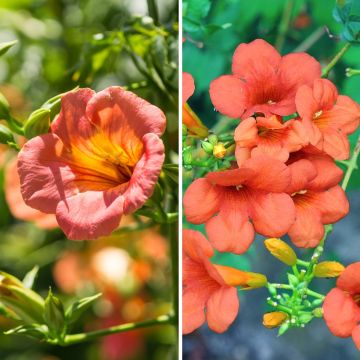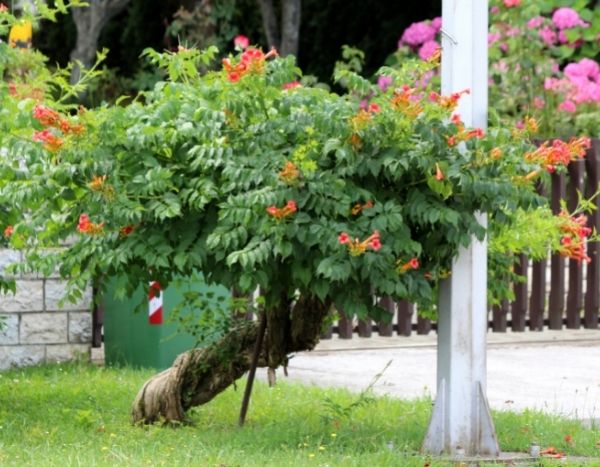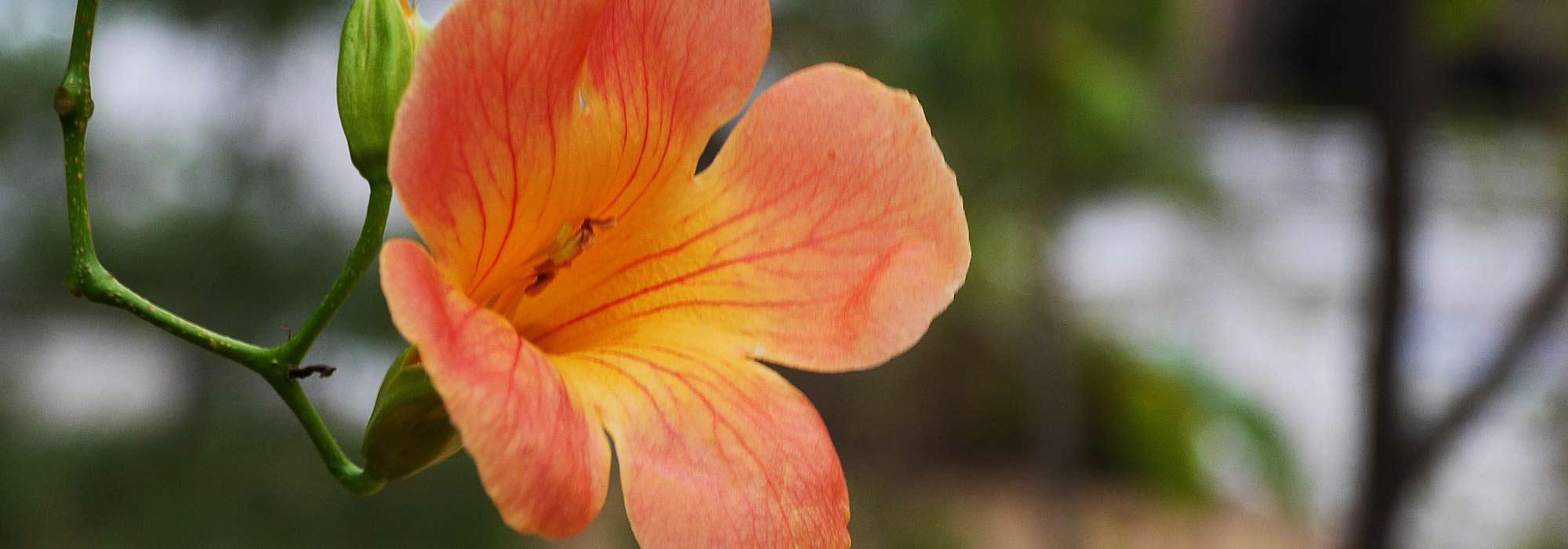

Pair of Campsis tagliabuana
Pair of Campsis tagliabuana
Campsis tagliabuana 'Takarazuka Fresa' Summer Jazz® Fire®, 'Takarazuka Yellow' Summer Jazz® Gold®
Italian Trumpet Vine, Madame Galen Trumpet Creeper
Arriving a bit under the weather, the plants didn't make it past 4 months.... Yet, I replanted and watered promptly.
Vinz , 12/02/2025
Special offer!
Receive a €20 voucher for any order over €90 (excluding delivery costs, credit notes, and plastic-free options)!
1- Add your favorite plants to your cart.
2- Once you have reached €90, confirm your order (you can even choose the delivery date!).
3- As soon as your order is shipped, you will receive an email containing your voucher code, valid for 3 months (90 days).
Your voucher is unique and can only be used once, for any order with a minimum value of €20, excluding delivery costs.
Can be combined with other current offers, non-divisible and non-refundable.
Home or relay delivery (depending on size and destination)
Schedule delivery date,
and select date in basket
This plant carries a 6 months recovery warranty
More information
We guarantee the quality of our plants for a full growing cycle, and will replace at our expense any plant that fails to recover under normal climatic and planting conditions.
Would this plant suit my garden?
Set up your Plantfit profile →
Collection items (2 plants)
Description
This pair of trumpet vines brings together two varieties from the 'Summer Jazz' series, 'Fire' and 'Gold', selected in Takarazuka, Japan for their compact growth and extraordinary flowering. These cold-resistant climbing plants are characterised by a very compact habit and a flowering that appears from the base of the plant throughout its height. Whether grown as bushes or used as climbers, their finely cut, fairly dark green foliage, covered with flowers for 3 months, is admired. These trumpet vines cling to their support thanks to branches with climbing roots. They find a place in all gardens, even the smallest ones, and will look lovely on sunny terraces.
This pair is composed of:
1 x Campsis Summer Jazz Fire: its branches reach a length of 3m, its deciduous foliage is absent in winter. Flowering begins in July in average climates, sometimes as early as June in mild climates, and lasts until September. The flowers bloom at the axil of the leaves, in clusters of 30cm, sometimes counting up to 60 trumpet-shaped flowers measuring 5 to 6cm long. They are bright red, with an apricot-tinted reverse and an orange throat. Gold Medal winner at Plantarium in 2014.
1 x Campsis Summer Jazz Gold: this variety has the same characteristics as the previous one, but its flowers are a different colour. They evolve from bright yellow to a warmer golden yellow, shaded with apricot. The throat is more orange and traversed by fine orange veins, tinged with red.
'Summer Jazz' trumpet vines are small, bushy, slow-growing vines. Their growth is easily controlled through regular pruning. They are happy in the sun, in any well-prepared soil, even slightly chalky and fairly dry in summer. If you grow them in pots, choose a container with a minimum volume of 40 litres, with drainage holes at the bottom, filled with potting soil. Shaped by regular pruning, they will form extraordinary bushes in a flowerbed, becoming the focal point of a small garden. They are also used in a classic way, to cover a wall, an unsightly building, a fence, a pillar, or a small gnarled tree. Space your plants 1m apart to allow them to develop harmoniously. You can plant small bushes at their base, such as bushy sage, choosing matching or complementary colours, a Cerastostigma willmottianum with small flowers of an unreal blue, a variegated spurge 'Tasmanian Tiger' to create s magical spectacle from July to September. Also, combine them with climbing plants with blue flowers such as Sollya heterophylla 'Ultra Blue' (in mild climates), an annual morning glory 'Heavenly Blue' or the very blue Clematis 'H F Young' to create a colourful scene.
Plant habit
Flowering
Foliage
Botanical data
Campsis
tagliabuana
'Takarazuka Fresa' Summer Jazz® Fire®, 'Takarazuka Yellow' Summer Jazz® Gold®
Bignoniaceae
Italian Trumpet Vine, Madame Galen Trumpet Creeper
Cultivar or hybrid
Other Campsis - Trumpet Creeper
View all →Planting and care
The 'Summer Jazz' trumpet vine is not very demanding on the nature of the soil, but it dislikes heavy, compact, poorly drained soils where moisture can stagnate. If the soil in your garden is too heavy, incorporate coarse sand or gravel before planting. It grows in any well-drained garden soil, even slightly chalky. It prefers a sunny exposure, except in the south where it will thrive in partial shade. Plant it along a well-exposed wall or against a tree, guiding it on a support. Water regularly during the first summers, or in case of prolonged drought. The plant can tolerate moderate periods of drought once established, especially if it is planted in deep soil. In the first few years, protect its crown from severe frost with a thick mulch.
Pruning is not essential. You can prune in late winter or early spring if necessary. In August-September, remove faded branches as well as the oldest shoots, recognisable by their cracked bark.
This trumpet vine can be trained as a small tree, just like a wisteria. Select the most beautiful stem to train on a sturdy support, deeply inserted in the soil. Then remove the secondary branches up to the desired height to form a trunk. Prune every year by removing stems that detract from the overall appearance.
Planting period
Intended location
Care
Planting & care advice
-
, onOrder confirmed
Reply from on Promesse de fleurs
Similar products
Haven't found what you were looking for?
Hardiness is the lowest winter temperature a plant can endure without suffering serious damage or even dying. However, hardiness is affected by location (a sheltered area, such as a patio), protection (winter cover) and soil type (hardiness is improved by well-drained soil).

Photo Sharing Terms & Conditions
In order to encourage gardeners to interact and share their experiences, Promesse de fleurs offers various media enabling content to be uploaded onto its Site - in particular via the ‘Photo sharing’ module.
The User agrees to refrain from:
- Posting any content that is illegal, prejudicial, insulting, racist, inciteful to hatred, revisionist, contrary to public decency, that infringes on privacy or on the privacy rights of third parties, in particular the publicity rights of persons and goods, intellectual property rights, or the right to privacy.
- Submitting content on behalf of a third party;
- Impersonate the identity of a third party and/or publish any personal information about a third party;
In general, the User undertakes to refrain from any unethical behaviour.
All Content (in particular text, comments, files, images, photos, videos, creative works, etc.), which may be subject to property or intellectual property rights, image or other private rights, shall remain the property of the User, subject to the limited rights granted by the terms of the licence granted by Promesse de fleurs as stated below. Users are at liberty to publish or not to publish such Content on the Site, notably via the ‘Photo Sharing’ facility, and accept that this Content shall be made public and freely accessible, notably on the Internet.
Users further acknowledge, undertake to have ,and guarantee that they hold all necessary rights and permissions to publish such material on the Site, in particular with regard to the legislation in force pertaining to any privacy, property, intellectual property, image, or contractual rights, or rights of any other nature. By publishing such Content on the Site, Users acknowledge accepting full liability as publishers of the Content within the meaning of the law, and grant Promesse de fleurs, free of charge, an inclusive, worldwide licence for the said Content for the entire duration of its publication, including all reproduction, representation, up/downloading, displaying, performing, transmission, and storage rights.
Users also grant permission for their name to be linked to the Content and accept that this link may not always be made available.
By engaging in posting material, Users consent to their Content becoming automatically accessible on the Internet, in particular on other sites and/or blogs and/or web pages of the Promesse de fleurs site, including in particular social pages and the Promesse de fleurs catalogue.
Users may secure the removal of entrusted content free of charge by issuing a simple request via our contact form.
The flowering period indicated on our website applies to countries and regions located in USDA zone 8 (France, the United Kingdom, Ireland, the Netherlands, etc.)
It will vary according to where you live:
- In zones 9 to 10 (Italy, Spain, Greece, etc.), flowering will occur about 2 to 4 weeks earlier.
- In zones 6 to 7 (Germany, Poland, Slovenia, and lower mountainous regions), flowering will be delayed by 2 to 3 weeks.
- In zone 5 (Central Europe, Scandinavia), blooming will be delayed by 3 to 5 weeks.
In temperate climates, pruning of spring-flowering shrubs (forsythia, spireas, etc.) should be done just after flowering.
Pruning of summer-flowering shrubs (Indian Lilac, Perovskia, etc.) can be done in winter or spring.
In cold regions as well as with frost-sensitive plants, avoid pruning too early when severe frosts may still occur.
The planting period indicated on our website applies to countries and regions located in USDA zone 8 (France, United Kingdom, Ireland, Netherlands).
It will vary according to where you live:
- In Mediterranean zones (Marseille, Madrid, Milan, etc.), autumn and winter are the best planting periods.
- In continental zones (Strasbourg, Munich, Vienna, etc.), delay planting by 2 to 3 weeks in spring and bring it forward by 2 to 4 weeks in autumn.
- In mountainous regions (the Alps, Pyrenees, Carpathians, etc.), it is best to plant in late spring (May-June) or late summer (August-September).
The harvesting period indicated on our website applies to countries and regions in USDA zone 8 (France, England, Ireland, the Netherlands).
In colder areas (Scandinavia, Poland, Austria...) fruit and vegetable harvests are likely to be delayed by 3-4 weeks.
In warmer areas (Italy, Spain, Greece, etc.), harvesting will probably take place earlier, depending on weather conditions.
The sowing periods indicated on our website apply to countries and regions within USDA Zone 8 (France, UK, Ireland, Netherlands).
In colder areas (Scandinavia, Poland, Austria...), delay any outdoor sowing by 3-4 weeks, or sow under glass.
In warmer climes (Italy, Spain, Greece, etc.), bring outdoor sowing forward by a few weeks.





























































